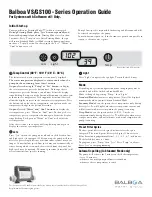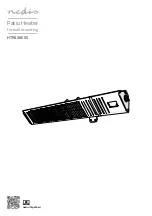
2) PLUMBING HOOK-UP
1) The unit is supplied with compression fittings. USE THESE: DO NOT
USE THREADED PIPE FITTINGS. DO NOT USE PIPE DOPE
OR TEFLON TAPE ON THIS INSTALLATION. Ensure the inlet filter supplied
with this unit is in place.
2) Take care to ensure that the pipes are correctly aligned with the inlet and
outlet bosses in order to avoid excessive stress on the heater body molding.
NOTE: Run water through the supply pipe to remove all debris from the
pipe before connecting the heater. Failure to do so could damage the flow
switch.
3) Install isolating valves (full flow ball valve type) on both inlet and outlet
pipes. This allows unit to be isolated for maintenance purposes. (Fig. 2)
4) When all plumbing is complete, fully check the system for water leaks
at all plumbing connections. If leak is present take corrective action. If leak
is at the compression fitting, slowly tighten compression nut until it stops.
Ensure compression fittings are tighten to 18FT.LB.
Fully open both inlet and outlet ball valves.
Run all hot water outlets fed by this heater one at a time for a minute or two
until the water flow is continuous, free from “gulping” and from all visible air
4) COMMISSIONING YOUR HEATER
IMPORTANT
Before switching “on” the power at the breaker make sure that the hot
water circuit is free of air pockets or premature failure of the heating element will occur.
To do this open all hot water faucets one at a time for a minute or two until the water flow
is continuous and free from “gulping” and from visible air pockets.
1) With inlet and outlet BALL VALVES fully open, turn on all hot water outlets.
2) Run for 5 minutes, turning faucet “on” and “off” repeatedly.
3) Switch on electric supply at breaker.
4) The power indicator light should now come on (see Fig. 1).
NOTE: At this point water temperature may not be very hot.
5) Using the OUTLET BALL VALVE slowly reduce water flow until desired
temperature is achieved at hot water outlet.
NOTE: The water temperature is proportional to the flow through the heater.
until the water flow is continuous, free from “gulping” and from all visible air
pockets.
NOTE:
ALL PLUMBING MUST BE COMPLETED BEFORE YOU
PROCEED WITH THE ELECTRICAL HOOK-UP.
TEST THE INSTALLATION FOR LEAKS BEFORE
CONNECTING THE ELECTRICAL SUPPLY.
NOTE: The water temperature is proportional to the flow through the heater.
The lower the flow the higher the temperature and vice versa
.
6) Check performance of flow switch by opening and closing outlet valve a few times.
The power indicator light should be on
ONLY
when water is flowing through the unit.
For expected temperature rise at various rates of flow see chart.
NOTE: An SP55 (5.5 kW) unit at 240 V will deliver 0.5 gallon per minute at 75
o
F
temperature rise. For example, with incoming water temperature at 45
o
F the
unit will produce 0.5 gallon per minute at (45+75)=120
o
F.
7) It is possible that drawing off cold water at comparatively high rates of flow
elsewhere in the building at the same time that the heater is working, could
cause premature element failure. Care should be taken not to starve the unit
of cold water. To prevent this from happening, open fully the main valve on
the cold supply to the building and throttle back the control valves to the other
cold water outlets.
Hot outlet
compression
fitting
DO NOT
SOLDER
Fig 1
Note: “Single Point” units comes with a faucet mounted aerators, these should
be mounted on the faucets served by this unit.
Cold inlet
Compression
FITTING
DO NOT
SOLDER
Inlet
filter
screen






















